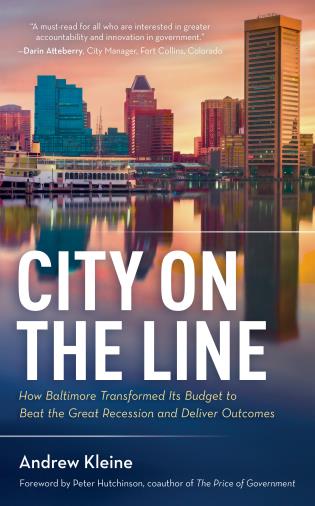
City on the Line is full of stories about public servants working to change an entrenched budget system. The following excerpt is one of these stories, about an agency head who went from fighting Outcome Budgeting to using it to change his agency for the better.
Previously: An Interview with Andrew Kleine, Author of City of the Line
‘I Hated It’
Alvin Gillard hated Outcome Budgeting when it started. He thought it was unfair to agencies like his – the Office of Civil Rights – that lacked the capacity to write great service proposals and could not be measured by “how many widgets they produced.” He fought the process that first year, but in the second year decided to stop fighting and figure out how to make it work. The result is a great example of how Outcome Budgeting can motivate organizations to reinvent themselves.
Alvin was born in 1954, the year of the Supreme Court’s Brown v. Board of Education decision. Now the executive director of Maryland’s Commission on Civil Rights, he has spent nearly forty years working to fulfill the promise of that landmark decision, fighting discrimination and ensuring equal opportunity for all people.
Growing up on the east side of Baltimore, in what is now called the Clifton Park neighborhood, Alvin saw things change rapidly after the school desegregation order. White families moved to the suburbs. His elementary school was nearly all black, and he remembers that in the aftermath of the 1968 riot, his diverse classmates at Herring Run Jr. High were sharply divided along racial lines between Nixon and Humphrey for president.
The neighborhood held on thanks to people like Alvin’s father, who never missed a day of work at the Bethlehem Steel mill at Sparrows Point, just southeast of the city on the Patapsco River. He and his wife showed their three boys the importance of faith, responsibility, and relationships, and saw them become successful adults. Occasionally, Alvin will drive through his old neighborhood on the way home from work. “It’s not even the same place,” he says. White flight and the disappearance of blue collar jobs (the steel mill closed years ago) eventually took their toll. What Alvin remembers as a “self-contained community,” with corner stores, small businesses, and Arabbers selling fresh fruits and vegetables from horse-drawn carts, is now a wasteland of vacant lots, shuttered storefronts, and neglect. “There’s no community pride left,” he sighs.
Having spent his formative years in the midst of the civil rights struggle, it’s no wonder that Alvin joined the cause with passion in 1980, when he signed on as an investigator with Baltimore’s Community Relations Commission. He recalls that in those days, there were as many Jews as African-Americans doing civil rights work. There are not enough whites in the field anymore, he says, and the people he hires nowadays are just looking for a job, not answering the call. “People no longer see public service as the best way to make a difference.”
With the urgency of the civil rights movement fading into history, Alvin says his agency had become “comfortable” and was never challenged to reexamine its mission and how it did business. Outcome Budgeting forced Alvin and his team to confront some hard truths. As they started to measure their performance, they realized that they had taken on more nice-to-do programs and initiatives than they could manage with their resources. They were spread too thin and not doing anything well, including the core work of investigating and resolving discrimination complaints.
In its service proposal for the second year of Outcome Budgeting, the Office of Civil Rights set ambitious targets for improving the timeliness of its case work. According to Alvin, paring down the mission to its core freed the staff to focus on improving service delivery, and measuring performance gave them the “discipline and focus” to reach for ambitious goals.
In thinking about how to do a better job of resolving cases, the team got creative. Cutting back on competing priorities was only part of the solution. It would help get more cases done more quickly, but timeliness was not the only measure of success, or even the most important one. The team wanted to resolve cases in a way that strengthened communities and made a lasting impact on human relations, so they decided to acquire new skills in conflict resolution to mediate disputes. Resolving more cases through negotiation, as opposed to adjudication, became a measure of successful outcomes.

This chart, from Baltimore’s Scorecard performance management system, shows that Alvin set an audacious target of more than doubling negotiated settlements in one year. The Office of Civil Rights got more realistic in succeeding years but didn’t stop working to get better, notching a 40% improvement over three years.
One of Alvin’s mentors was the late Clarence “Du” Burns, a longtime Baltimore City Councilman who became the city’s first black mayor when William Donald Schaefer was elected governor of Maryland. Alvin interned for Burns as a student at Morgan State. He calls Burns “the most practical politician I’ve ever known.” “He knew he needed to be a cut above the white politicians, and while he may not have been as educated or articulate, he knew how to get things done.” Getting things done in a practical way is how Alvin turned around the Office of Civil Rights. “Du” Burns would have been proud.
